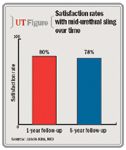Article
Durable success rates seen with mid-urethral sling
A retropubic mid-urethral sling showed a success rate of 81% and a satisfaction rate of 78% at an average follow-up of 68 months (range, 60-88 months) in a recent study.
Phoenix-A retropubic mid-urethral sling showed a success rate of 81% and a satisfaction rate of 78% at an average follow-up of 68 months (range, 60-88 months) in a recent study.
The study, by researchers at Virginia Mason Medical Center, Seattle, examined the durability of the SPARC retropubic polypropylene mid-urethral sling (American Medical Systems, Minnetonka, MN).
"To date, this Virginia Mason data represents the longest published follow-up following SPARC placement and can be considered valuable information to be given to patients during pre-procedure counseling," said first author Jason Kim, MD.
Success was defined in the study as one or fewer episodes of incontinence per week or a patient-reported 70% improvement in symptoms.
Low decline in satisfaction rate
In speaking with Urology Times, Dr. Kim, a urologist in private practice affiliated with Virginia Mason, called attention to the difference in self-reported satisfaction at 1 year and greater than 5 years. The 80% reported satisfaction rate at 1 year fell only two percentage points to 78% at 5 years.

To arrive at their findings, the researchers delved into Virginia Mason database to identify 79 patients who had undergone a SPARC and met study criteria. Dr. Kim said that senior author Kathleen Kobashi, MD, had established a comprehensive database in 1999 to follow all patients who underwent anti-incontinence procedures at Virginia Mason Medical Center. The institution began using the SPARC in 2001. Only patients who had responded to both an early postoperative questionnaire and a questionnaire at 5 years or longer were considered by the research team.
"In this study, age appeared to be a factor that increased the risks of failure, but this could not be determined with absolute certainty," said Dr. Kim.
"We looked at patient characteristics among those women who experienced initial success and went on to fail at 5 years. The average age of this group was 62. Conversely, the average age of those who had initial success and remained successful at long-term follow-up was 55. There may be other factors, but the study was not powered for multivariate analysis.
"The take-home message is that SPARC shows good results at both short- and long-term follow-up. We can now confidently tell patients that if they are initially satisfied at 1 year, the probability is that they will remain satisfied at 5 years," Dr. Kim said.

Navigating work-life balance: VUMC’s Family Planning for Surgeons Series

Investigators identify potential dual targets in prostate cancer



